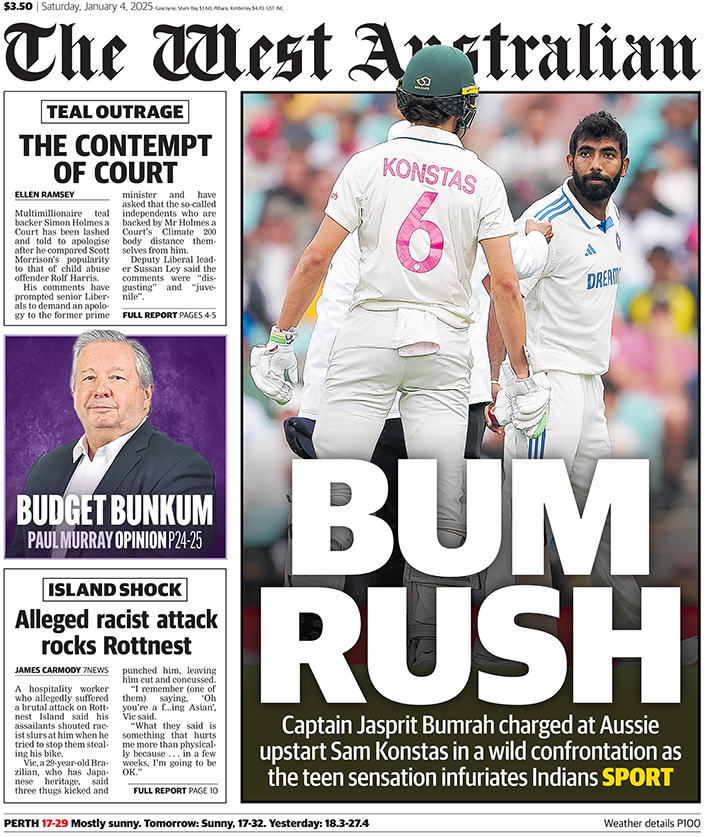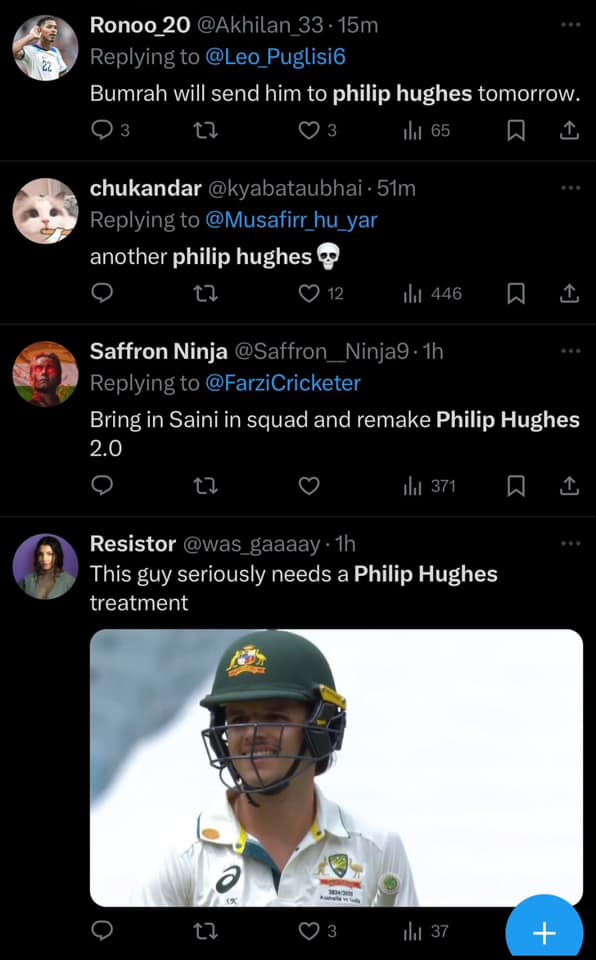Australia has been rocked by dual controversies stemming from the recently concluded cricket series between India and Australia. Allegations of racism and hateful conduct have ignited widespread outrage.
Racist undertones on the front page of The West Australian
The West Australian newspaper has come under fire for its front-page headline on January 4, 2025. The headline, “BUM RUSH,” accompanied a photo of Indian fast bowler and stand-in captain Jasprit Bumrah confronting Australian batter Sam Konstas during the series decider at the Sydney Cricket Ground. The headline has been criticised as racially insensitive, mocking Bumrah’s ethnic name.

Perth-based community advocate Suresh Rajan voiced his strong objections in a letter to the editor, which he later shared publicly. In the letter, Rajan described the headline as “crass, specious, and downright racist.” He accused the publication of promoting “gutter journalism” and lamented how this form of mockery perpetuates stereotypes and incites hatred.
“This is not an inherent endearing trait of Australians,” Rajan wrote, citing his personal experience with the mispronunciation of his own name over 50 years. “After the first few years, all it demonstrated was sheer ignorance and arrogance of the speaker.”
The newspaper has yet to respond to the widespread backlash, but Rajan’s letter has drawn significant attention online, with many calling for an apology from the publication.
Online abuse targeting players

The controversy extends beyond the media to social media, where some Indian fans have come under scrutiny for hateful comments targeting 19-year-old Australian batter Sam Konstas. Several posts referenced the late cricketer Phil Hughes, who tragically died in 2014 after being struck on the neck by a bouncer.
One post chillingly read, “Bumrah will send him to Philip Hughes tomorrow,” while another stated, “This guy seriously needs a Phil Hughes treatment.” The comments have drawn widespread condemnation for their insensitivity, with cricketing communities urging stricter action against such toxic behaviour online.
Amar Singh, President and Founder of charity organisation Turbans 4 Australia and the 2023 Australian Local Hero awardee, weighed in on the matter. Writing on Facebook, Singh said, “Every game brings communities and countries together to celebrate and enjoy the sportsmanship. Millions around the globe enjoy and hundreds of thousands of people fill the stadiums boosting millions of dollars to the local economy. Sadly, cricket brings a vile side of some people. We have been inundated with screenshots of hate-filled messages and comments. In 2025-25, where do we stand?”
Singh added, “In my opinion, Cricket Australia should invest in harmony and respect both on and off the fields. We love cricket—in fact, all sports—we were glad to tie turbans across Australia for the test matches in Perth, Brisbane, and Melbourne. There needs to be a better benchmark for Australians of ethnic backgrounds not to be left victimised and on the receiving end of passive racism and intimidating commentary. Let’s all work towards a more positive and harmonious future for our future generations.”
Context: Racism allegations at the MCG
The incidents come in the wake of ongoing allegations of racism at the Melbourne Cricket Ground (MCG), where Indian spectators have been subjected to racist chants, including “Where’s your visa?” A video of the incident quickly went viral, reigniting concerns about crowd behaviour and racism in cricket. This echoes the 2021 Sydney Cricket Ground (SCG) Test controversy, where Indian cricketers Mohammed Siraj and Jasprit Bumrah were subjected to racial abuse.

The video has sparked widespread outrage, with many pointing out that such behaviour tarnishes the spirit of sportsmanship. Adding to the controversy, social media has become a hotbed of xenophobic commentary targeting Indian migrants. Comments such as “send back all the immigrants” and “good luck getting an Uber” have been circulating, highlighting the deep-seated prejudice faced by Indian Australians.
Both the Indian and Australian cricket boards have strongly condemned the behaviour, and Cricket Australia has launched an investigation into the crowd conduct.
This incident coincides with Australia’s recently released anti-racism framework, which acknowledges the persistent prevalence of racism. Additionally, a report by the Human Rights Law Centre (HRLC) links Australia’s new anti-migrant laws to a rise in xenophobic attitudes. These policies and sentiments disproportionately affect Indian migrants, who are among the largest immigrant communities in Australia.
The MCG episode also mirrors the challenges faced by the Indian diaspora in the United States, where debates over H-1B visas have sparked similar waves of hate messaging and xenophobia. In both cases, these incidents serve as reminders of the vulnerabilities faced by Indian migrants in multicultural societies.
Cricket’s battle with toxicity
These developments highlight the ongoing challenges faced by cricket in addressing racism and toxicity, both in the stands and online. Advocates have called for greater accountability from media organisations and social media platforms in setting higher standards of discourse in sports.
The series concluded on Sunday, with Australia reclaiming the Border-Gavaskar Trophy after a decade. However, the controversies surrounding the matches have cast a shadow over the achievement, reigniting calls for stronger measures to foster respect among fans, players, and media stakeholders.











